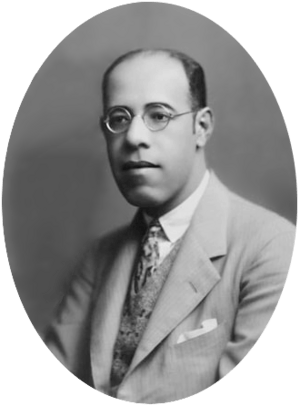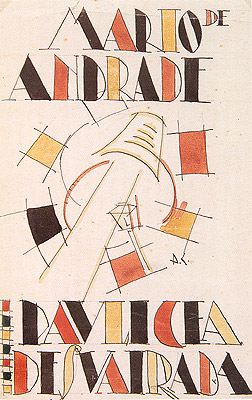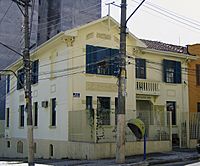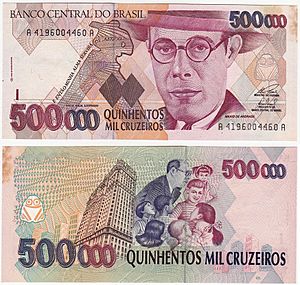Mário de Andrade facts for kids
Quick facts for kids
Mário de Andrade
|
|
|---|---|

Mário de Andrade at age 35, 1928
|
|
| Born | Mário Raul de Moraes Andrade October 9, 1893 São Paulo, Brazil |
| Died | February 25, 1945 (aged 51) São Paulo, Brazil |
| Occupation | Poet, novelist, musicologist, art historian, critic and photographer |
| Literary movement | Modernism |
| Notable works | Macunaíma |
Mário Raul de Morais Andrade (October 9, 1893 – February 25, 1945) was a Brazilian poet, novelist, musicologist, art historian and critic, and photographer. He wrote one of the first and most influential collections of modern Brazilian poetry, Paulicéia Desvairada (Hallucinated City), published in 1922. He has had considerable influence on modern Brazilian literature, and as a scholar and essayist—he was a pioneer of the field of ethnomusicology—his influence has reached far beyond Brazil.
Andrade was a central figure in the avant-garde movement of São Paulo for twenty years. Trained as a musician and best known as a poet and novelist, Andrade was personally involved in virtually every discipline that was connected with São Paulo modernism. His photography and essays on a wide variety of subjects, from history to literature and music, were widely published. He was the driving force behind the Week of Modern Art, the 1922 event that reshaped both literature and the visual arts in Brazil, and a member of the avant-garde "Group of Five." The ideas behind the Week were further explored in the preface to his poetry collection Pauliceia Desvairada, and in the poems themselves.
After working as a music professor and newspaper columnist he published his great novel, Macunaíma, in 1928. Work on Brazilian folk music, poetry, and other concerns followed unevenly, often interrupted by Andrade's shifting relationship with the Brazilian government. At the end of his life, he became the founding director of São Paulo's Department of Culture, formalizing a role he had long held as a catalyst of the city's—and the nation's—entry into artistic modernity.
Contents
Early life
Andrade was born in São Paulo and lived there virtually all of his life. As a child, he was a piano prodigy, and he later studied at the Music and Drama Conservatory of São Paulo. His formal education was solely in music, but at the same time, as Albert T. Luper records, he pursued persistent and solitary studies in history, art, and particularly poetry. Andrade had a solid command of French, and read Rimbaud and the major Symbolists. Although he wrote poetry throughout his musical education, he did not think to do so professionally until the career as a professional pianist to which he aspired was no longer an option.
In 1913, his 14-year-old brother Renato died suddenly during a football game; Andrade left the Conservatory to stay at Araraquara, where his family had a farm. When he returned, his piano playing was afflicted intermittently by trembling of his hands. Although he ultimately did receive a degree in piano, he gave no concerts and began studying singing and music theory with an eye toward becoming a professor of music. At the same time, he began writing more seriously. In 1917, the year of his graduation, he published his first book of poems, Há uma Gota de Sangue em Cada Poema (There is a drop of blood in each poem), under the pseudonym Mário Sobral. The book contains hints of Andrade's growing sense of a distinctive Brazilian identity, but it does so within the context of a poetry that (like most Brazilian poetry of the period) is strongly indebted to earlier European—particularly French—literature.
His first book does not seem to have had an enormous impact, and Andrade broadened the scope of his writing. He left São Paulo for the countryside, and began an activity that would continue for the rest of his life: the meticulous documentation of the history, people, culture, and particularly music of the Brazilian interior, both in the state of São Paulo and in the wilder areas to the northeast. He published essays in São Paulo magazines, accompanied occasionally by his own photographs, but primarily he accumulated massive amounts of information about Brazilian life and folklore. Between these trips, Andrade taught piano at the Conservatory, and became one of its professors in 1921.
The Week of Modern Art
While these folklore-gathering trips were going on, Andrade developed a group of friends among young artists and writers in São Paulo, who, like him, were aware of the growing modernist movement in Europe. Several of them were later known as the Grupo dos Cinco (the Group of Five): Andrade, poets Oswald de Andrade (no relation) and Menotti del Picchia, and artists Tarsila do Amaral and Anita Malfatti.
Andrade worked on the book, titled Paulicéia Desvairada in Portuguese, for two years.
These poems were entirely different from his earlier formal and abstract work. The lines of verse vary greatly in length and in syntactical structure, consisting primarily of impressionistic and fragmented descriptions interspersed with seemingly overheard, disconnected bits of speech in São Paulo dialect. The speaker of the poems often seems overwhelmed by the maze of dialogue that constantly interrupts him, as in "Colloque Sentimental":
|
A rua toda nua ... As casas sem luzes ... |
The street all naked ... The lightless houses ... |
In 1922, while preparing Paulicéia Desvairada for publication, Andrade collaborated with Malfatti and Oswald de Andrade in creating a single event that would introduce their work to the wider public: the Semana de Arte Moderna (Week of Modern Art). The Semana included exhibitions of paintings by Malfatti and other artists, readings, and lectures on art, music, and literature. Andrade was the chief organizer and the central figure in the event, which was greeted with skepticism but was well-attended. He gave lectures on both the principles of modernism and his work in Brazilian folk music, and read his "Extremely Interesting Preface." As the climactic event of the Semana, he read from Paulicéia Desvairada. The poems' use of free verse and colloquial São Paulo expressions, though related to European modernist poems of the same period, were entirely new to Brazilians. The reading was accompanied by persistent jeers, but Andrade persevered, and later discovered that a large part of the audience found it transformative. It has been cited frequently as the seminal event in modern Brazilian literature.
The Group of Five continued working together in the 1920s, during which their reputations solidified and hostility to their work gradually diminished, but eventually the group split apart; Andrade and Oswald de Andrade had a serious (and public) falling-out in 1929. New groups were formed out of the splinters of the original, and in the end many different modernist movements could trace their origins to the Week of Modern Art.
"The apprentice tourist"
Throughout the 1920s Andrade continued traveling in Brazil, studying the culture and folklore of the interior. He began to formulate a sophisticated theory of the social dimensions of folk music, which is at once nationalistic and deeply personal. Andrade's explicit subject was the relationship between "artistic" music and the music of the street and countryside, including both Afro-Brazilian and Amerindian styles. The work was controversial for its formal discussions of dance music and folk music; those controversies were compounded by Andrade's style, which was at once poetic (Luper calls it "Joycean") and polemical.
His travels through Brazil became more than just research trips; in 1927, he started writing a travelogue called "The apprentice tourist" for the newspaper O Diario Nacional. The column served as an introduction for cosmopolites to indigenous Brazil. At the same time, it served as an advertisement for Andrade's own work. A number of Andrade's photographs were published alongside the column, showing the landscape and people. Occasionally, Andrade himself would appear in them, usually filtered through the landscape, as in the self-portrait-as-shadow on this page. His photographs thus served to further his modernist project and his own work at the same time as their function in recording folklore.
Though Andrade continued taking photographs throughout his career, these images from the 20s comprise the bulk of his notable work, and the 1927 series in particular. He was particularly interested in the capacity of photographs to capture or restate the past, a power he saw as highly personal. In many of the images, figures are shadowed, blurred, or otherwise nearly invisible, a form of portraiture that for Andrade became a kind of modernist sublime.
Macunaíma
At the same time, Andrade was developing an extensive familiarity with the dialects and cultures of large parts of Brazil. He started to apply to prose fiction the speech-patterned technique he had developed in writing the poems of Hallucinated city. He wrote two novels during this period using these techniques: the first, Love, Intransitive Verb, was largely a formal experiment.; the second, written shortly after and published in 1928, was Macunaíma, a novel about a man ("The hero without a character" is the subtitle of the novel) from an indigenous tribe who comes to São Paulo, learns its languages—both of them, the novel says: Portuguese and Brazilian—and returns. The style of the novel is composite, mixing vivid descriptions of both jungle and city with abrupt turns toward fantasy, the style that would later be called magical realism.
Macunaíma, regarded by academic critics as an awkwardly constructed work of more historical than literary importance, has come to be recognized as a modernist masterpiece whose difficulties are part of its aesthetic. Andrade is a national cultural icon; his face has appeared on the Brazilian currency. A film of Macunaíma was made in 1969, by Brazilian director Joaquim Pedro de Andrade, updating Andrade's story to the 1960s and shifting it to Rio de Janeiro; the film was rereleased internationally in 2009.
Late life and musical research
Andrade was not directly affected by the Revolution of 1930, in which Getúlio Vargas seized power and became dictator, but he belonged to the landed class the Revolution was designed to displace, and his employment prospects declined under the Vargas regime. He was able to remain at the Conservatory, where he was now Chair of History of Music and Aesthetics. With this title he became a de facto national authority on the history of music, and his research turned from the personal bent of his 1920s work to textbooks and chronologies. He continued to document rural folk music, and during the 1930s made an enormous collection of recordings of the songs and other forms of music of the interior. The recordings were exhaustive, with a selection based on comprehensiveness rather than an aesthetic judgment, and including context, related folktalkes, and other non-musical sound. Andrade's techniques were influential in the development of ethnomusicology in Brazil and predate similar work done elsewhere, including the well-known recordings of Alan Lomax. He is credited with coining the word "popularesque," which he defined as imitations of Brazilian folk music by erudite urban musicians ("erudite" is generally a deprecation in Andrade's vocabulary). The word continues to have currency in discussion of Brazilian music as both a scholarly and nationalist category.
In 1935, during an unstable period in Vargas's government, Andrade and writer and archaeologist Paulo Duarte, who had for many years desired to promote cultural research and activity in the city through a municipal agency, were able to create a unified São Paulo Department of Culture (Departamento de Cultura e Recreação da Prefeitura Municipal de São Paulo). Andrade was named founding director. The Department of Culture had a broad purview, overseeing cultural and demographic research, the construction of parks and playgrounds, and a considerable publishing wing. Andrade approached the position with characteristic ambition, using it to expand his work in folklore and folk music while organizing myriad performances, lectures, and expositions. He moved his collection of recordings to the Department, and expanding and enhancing it became one of the Department's chief functions, overseen by Andrade's former student, Oneyda Alvarenga. The collection, called the Discoteca Municipal, was "probably the largest and best-organized in the entire hemisphere."
At the same time, Andrade was refining his theory of music. He attempted to pull together his research into a general theory. Concerned as always with Modernismo's need to break from the past, he formulated a distinction between the classical music of 18th- and 19th-century Europe, and what he called the music of the future, which would be based simultaneously on modernist breakdowns of musical form and on an understanding of folk and popular music. The music of the past, he said, was conceived in terms of space: whether counterpoint, with its multiple voices arranged in vertical alignment, or the symphonic forms, in which the dominant voice is typically projected on top of a complex accompaniment. Future music would be arranged in time rather than space: "moment by moment" (in Luper's translation). This temporal music would be inspired not by "contemplative remembrance", but by the deep longing or desire expressed by the Portuguese word saudade.
Through his position at the Department of Culture in this period, he was able to assist Dina Lévi-Strauss and her husband, Claude Lévi-Strauss with films they were making based on field research in Mato Grosso and Rondônia.
Andrade's position at the Department of Culture was abruptly revoked in 1937, when Vargas returned to power and Duarte was exiled. In 1938 Andrade moved to Rio de Janeiro to take up a post at the Universidade Federal do Rio de Janeiro. While there he directed the Congresso da Língua Nacional Cantada (Congress of National Musical Language), a major folklore and folk music conference. He returned to São Paulo in 1941, where he worked on a collected edition of his poetry.
Andrade's final project was a long poem called "Meditação Sôbre o Tietê." The work is dense and difficult, and was dismissed by its early critics as "without meaning", although recent work on it has been more enthusiastic. One critic, David T Haberly, has compared it favorably to William Carlos Williams's Paterson, a dense but influential unfinished epic using composite construction. Like Paterson, it is a poem about a city; the "Meditação" is centered on the Tietê River, which flows through São Paulo. The poem is simultaneously a summation of Andrade's career, commenting on poems written long before, and a love poem addressed to the river and to the city itself. In both cases, the poem hints at a larger context: it compares the river to the Tagus in Lisbon and the Seine in Paris, as if claiming an international position for Andrade as well. At the same time, the poem associates both Andrade's voice and the river with "banzeiro," a word from the Afro-Brazilian musical tradition: music that can unite man and river. The poem is the definitive and final statement of Andrade's ambition and his nationalism.
Death
Andrade died at his home in São Paulo of a heart attack on February 25, 1945, at the age of 51. Because of his tenuous relationship with the Vargas regime, the initial official reaction to his career was muted. However, the publication of his Complete Poems in 1955 (the year after Vargas's death) signalled the start of Andrade's canonization as one of the cultural heroes of Brazil. On February 15, 1960, the municipal library of São Paulo was renamed Biblioteca Mário de Andrade.
See also
 In Spanish: Mário de Andrade para niños
In Spanish: Mário de Andrade para niños






